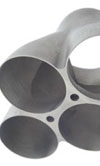Advanced aluminium alloys
 The previous article (Pin Critical) on Advanced Metals last month continued on the subject of titanium alloys. This month, we shall look in more detail at some of the more exotic aluminium alloys which are available, following on from a previous article in this vein.
The previous article (Pin Critical) on Advanced Metals last month continued on the subject of titanium alloys. This month, we shall look in more detail at some of the more exotic aluminium alloys which are available, following on from a previous article in this vein.
Whilst in some applications, a low modulus material is very useful (fasteners for example can benefit from having a low elastic modulus), in many of the applications where aluminium is used, high stiffness would be a useful benefit to the designer. Most aluminium alloys have a modulus of around 70 GPa (10,000,000 psi), which is approximately one third of the elastic modulus of steel. Without resort to the addition of particulates to the material i.e. powder reinforced metal-matrix composites, there are commercially available materials used in other industries which offer a substantial advantage over conventional aluminium alloys in terms of stiffness.
Again, some engineers (Formula One again) are limited by the ‘glass walls’ imposed by regulations. The regulation which applies here is that limiting specific modulus of elasticity to be less than 40 GPa / (g/cc). This specific modulus is the ratio of elastic modulus to density. We would typically be comfortably within this limit. As examples, 7075 and 6061 both have a specific modulus of 25.5 GPa / (g/cc), and this is typical for conventional alloys.
By specifically increasing the content of certain elements, it is possible to create aluminium alloys with a specific stiffness far exceeding those typical values. The methods of processing these special alloys are very different to those generally used, with incredibly high rates of cooling used to promote a very unusual material microstructure. One particular example produced in Europe, which is commercially available to all of us, has a specific stiffness of 53.3; this being comfortably more than twice the typical value. However, in Formula One, engineers cannot use this. There are though several alloys which fall below the mandated limit which would be of interest to Formula One engine design engineers, some of which are also blessed with high-temperature capabilities, making them possible replacements for alloys such as 2618 in some applications.
So, what are the disadvantages of these alloys in terms of their mechanical properties? Many of them suffer from low ductility. Whilst ductility is a property associated with plastic deformation, it is of significance to those of us aiming to design parts which we believe to operate in the elastic region of the load deformation curve. Where there is contact, we often require the material to have a certain amount of ductility to allow the contact to conform slightly, especially at the edges of highly-loaded contact regions. Where ductility is too low, lack of ductility can lead to cracking and consequently low fatigue life. If we aim to introduce these alloys, we have to design our contact areas pretty carefully. As an example, alloys of this type often have less than 3% elongation, and in some cases around 1%. Sometimes, although not always, these materials can suffer from low tensile and fatigue strength. However, some of these materials display high tensile strength and exceptional fatigue strength compared to standard alloys. Experimental very highly alloyed aluminium alloys produced only in extremely small quantities, by the same methods as the high-stiffness alloys above, have recorded fracture strengths approaching 1500 MPa (215 ksi)i
There are many applications within the racing engine where these alloys could be employed and they will doubtless become more popular as time goes on. The only limits at the moment are the availability of materials in sufficient quantities or in suitable sizes and the price, which is high in comparison with conventionally-processed alloys.
Written by Wayne Ward.